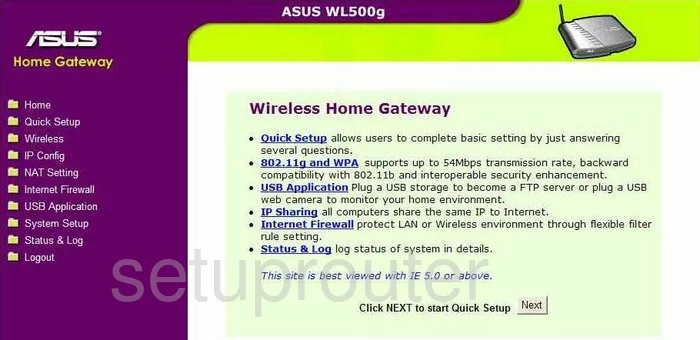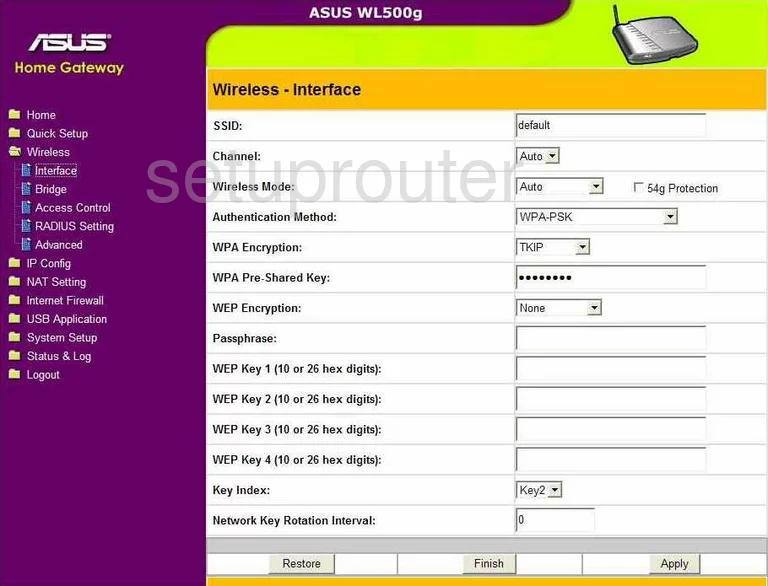The Asus WL-500G router is considered a wireless router because it offers WiFi connectivity. WiFi, or simply wireless, allows you to connect various devices to your router, such as wireless printers, smart televisions, and WiFi enabled smartphones.
Other Asus WL-500G Guides
This is the wifi guide for the Asus WL-500G. We also have the following guides for the same router:
- Asus WL-500G - How to change the IP Address on a Asus WL-500G router
- Asus WL-500G - Asus WL-500G Login Instructions
- Asus WL-500G - Asus WL-500G User Manual
- Asus WL-500G - Asus WL-500G Port Forwarding Instructions
- Asus WL-500G - How to change the DNS settings on a Asus WL-500G router
- Asus WL-500G - How to Reset the Asus WL-500G
- Asus WL-500G - Information About the Asus WL-500G Router
- Asus WL-500G - Asus WL-500G Screenshots
WiFi Terms
Before we get started there is a little bit of background info that you should be familiar with.
Wireless Name
Your wireless network needs to have a name to uniquely identify it from other wireless networks. If you are not sure what this means we have a guide explaining what a wireless name is that you can read for more information.
Wireless Password
An important part of securing your wireless network is choosing a strong password.
Wireless Channel
Picking a WiFi channel is not always a simple task. Be sure to read about WiFi channels before making the choice.
Encryption
You should almost definitely pick WPA2 for your networks encryption. If you are unsure, be sure to read our WEP vs WPA guide first.
Login To The Asus WL-500G
To get started configuring the Asus WL-500G WiFi settings you need to login to your router. If you are already logged in you can skip this step.
To login to the Asus WL-500G, follow our Asus WL-500G Login Guide.
Find the WiFi Settings on the Asus WL-500G
If you followed our login guide above then you should see this screen.

You begin on the Wireless Home Gateway page of the Asus WL-500g router. To configure your wireless settings, click the link on the left, in purple, labeled Wireless. Then under that, choose Interface.
Change the WiFi Settings on the Asus WL-500G

You should now be on the correct page. Things that need to be changed on this page are:
- The SSID - This is at the top of the page. The SSID is your network name. This is the name that you use to identify your network from the others around you. Create an original name, but avoid using any personal information here. Wireless names is a great guide on the topic if you need more information.
- Directly below that is the Channel - If your wireless internet is not as strong as you think it should be you may need to change the channel. In the United States there are 11 channels you can choose from. Of these 11 channels you need to be using only channel 1,6, or 11. WiFi channels is our guide that explains why you should only be using these three channels.
- Next is the Authentication Method - This is the security you use to transmit your data on the airwaves. WEP vs. WPA is a great guide describing the differences in the security modes. The best choice is WPA2-PSK. It looks as if this router does not support this choice though. Our recommendation is to update your firmware to allow for this authentication method. If you are unable to do this, WPA-PSK is the next best choice.
- Under that is the WPA Encryption - This is how your router encrypts the data you send and receive. There are two choices here, TKIP and AES. TKIP has some pretty big flaws which make it easier to hack. AES is the newest and most secure choice today.
- Next is the WPA Pre-Shared Key - This is your password. Create a strong password of at least 20 characters. Avoid using any personal information or dictionary words. If you need to use a word, make sure to misspell it. We do suggest using some symbols, capital letters, and numbers within the password. How to choose a strong password is a good guide on how to create a strong password that is easy to remember.
- Nothing else should be changed on this page, simply click the Apply button if you are happy with your settings.
That's it!
Possible Problems when Changing your WiFi Settings
After making these changes to your router you will almost definitely have to reconnect any previously connected devices. This is usually done at the device itself and not at your computer.
Other Asus WL-500G Info
Don't forget about our other Asus WL-500G info that you might be interested in.
This is the wifi guide for the Asus WL-500G. We also have the following guides for the same router:
- Asus WL-500G - How to change the IP Address on a Asus WL-500G router
- Asus WL-500G - Asus WL-500G Login Instructions
- Asus WL-500G - Asus WL-500G User Manual
- Asus WL-500G - Asus WL-500G Port Forwarding Instructions
- Asus WL-500G - How to change the DNS settings on a Asus WL-500G router
- Asus WL-500G - How to Reset the Asus WL-500G
- Asus WL-500G - Information About the Asus WL-500G Router
- Asus WL-500G - Asus WL-500G Screenshots